

Featured Article of the Month
Ryukyu Dynastic Food and Jimami Tofu
By Mr Jason Chan
| My wife and I had always had a penchant for Japan ever since I visited Hokkaido years ago and had a taste of Ryokans (traditional Japanese Inns) and the amazing kaiseki meals they served. I am a co-founder of a production company called BananaMana Films and I had always told my business partner we had to shoot in Japan - it was a dream of mine not only to capture the organically beautiful scenery of the smaller towns but also the kaiseki food which I considered some of the best cuisine I’d ever tasted. The preparation, taste and design of each meal was unsurpassed. We simply wanted to capture the beauty of the food, the landscape and the artistry of the presentation and hopefully through a story that would capture people’s hearts. | 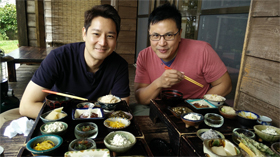 Jason Chan & Christian Lee (writers and directors of “Jimami Tofu”) at a village cafe south of Naha. |
| It was a dream come true when the Okinawa prefecture invited us to Okinawa to see if we could use it as a backdrop to one of our dramas but we found it wasn’t what we initially expected - it wasn’t really like the rest of mainland Japan. Walking the back streets one evening we happened on a little restaurant that served jimami tofu - a dish made of the essence of peanuts and with a sticky, starchy consistency reminiscent of soft tofu. We were intrigued and asked our fixer to introduce us to more traditional Okinawan cuisine. She took us to a little restaurant in Naha called Akatafuu. Run by just a husband and wife and serving only two tables a night we had an omakase Ryukyu dynastic meal which turned the tide for us. No longer were we going to use Okinawa as a backdrop - we decided then and there that the Ryukyu cuisine was going to be the forefront of our film - later to be called: “Jimami Tofu”. | 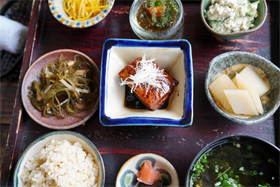 The Okinawan food we discovered at various restaurants and cafes. |
| What struck us about Ryukyu cuisine was that it was markedly different from traditional Japanese food. The influence of South-East Asia and China was very clear to us (being from Singapore). Not only the ingredients but the preparation methods - for example, they used woks and the same technique of stir frying that is so common amongst the Chinese. One of the ingredients that stuck out to us was bitter gourd, used in SE Asia quite commonly, which was one of their traditional dishes - stir fried with egg. They also stir fried kelp and used seaweed in tempura (asa tempura) which is unusual in mainland Japan. Although the presentation and design of some of the meals we went on to have were Japanese inspired - there was certainly a lot of SE Asian or Chinese cooking techniques, spices and ingredients used. | 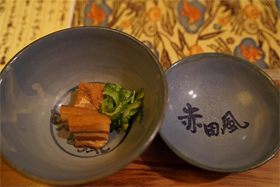 Bitter gourd and rafute - at Akatafuu - serving Omakase Ryukyu dynastic cuisine. |
| On digging further we discovered that the Ryukyu dynasty was an independent kingdom that ruled most of the Ryukyu Islands, which include Okinawa, from the 15th to the 19th century. Though a small kingdom, they played a very large role in trade for medieval East and South-East Asia. In fact, the Ryukyu Islands had tributary trade with Imperial China and later, though Japan invaded the kingdom, they eventually allowed them a large degree of autonomy because of their immense relationship with China. | 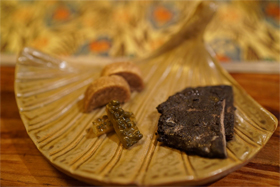 Other dishes from Akatafuu. |
| What a wonderful history for us to begin crafting a cross-cultural film about a Japanese Singapore love story set in Okinawa. We wanted to include elements of the history and of course the traditional food as a main character to both reflect and contrast the cultural drives and prejudices of the lead characters. We wanted to use the food and its rich history to drive growth particularly for the main character of Ryan (an aspiring chef from Singapore). | 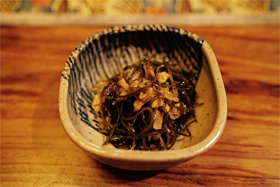 Other dishes from Akatafuu. |
| Of course we had to do a lot of research - a lot of eating! We worked initially with Chef Uchima from Nirai Kanai, the only Okinawan diner in Singapore, to discover the techniques behind the cooking of most of the dishes. We crafted the menu shown in the film mostly based on the omakase course we ate that fateful night at Akatafuu. Nuchigafu was another restaurant (in Naha) where we tasted traditional Okinawan cuisine mixed with some traditional Japanese elements. Beautifully presented, the food was also outstanding and the atmosphere was so gorgeous we used the premises as one of our shooting locations (to represent a Tokyo Japanese restaurant). | 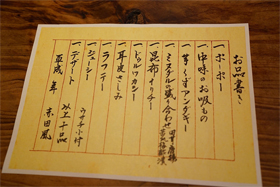 Menu from Akatafuu. |
| You will also notice that the architecture on the islands is unique and we loved visiting the villages outside the main city of Naha. There you’ll find little family run restaurants in stilt houses with tiny kitchens and sit-on-the floor dining. The dishes may not always be dynastic Ryukyu cuisine but the influences are there. By and large it’s cosy, heartwarming food in an atmosphere that makes you feel like you’re home. It was this sort of atmosphere that we wanted to permeate through our film and despite Okinawa being marketed mostly through its gorgeous beaches and landscapes - it was this homely, rustic, village life that we fell in love with. Our film “Jimami Tofu” is a homage to all of that, especially the home cooked food that graced these village restaurants. We found in Okinawa a home away from home that I’m sure all SE Asians will find both refreshing and somewhat familiar at the same time. | 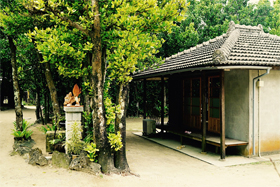 One of the traditional houses in a village outside of Bise, Okinawa. |
About the Author
|
Mr Jason Chan is co-writer/co-director of the award winning film “Jimami Tofu” which has had sell out screenings in 4 international film festivals so far (in Hawaii, San Francisco, LA, Okinawa) and also won the Audience Choice Award for Best Narrative Feature at the 37th Hawaii Intl Film Festival. The film was created by Singapore company BananaMana Films. The film will play to the public at a free screening at the Singapore Botanic Gardens as part of Heritage week (June 30th) and will also open at Golden Village gold class in August where it will include a special Okinawan course dinner.
* All photos used in this article are provided by the author / © Mr Jason Chan |
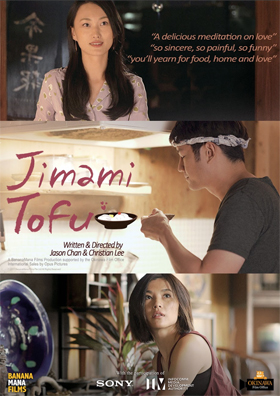 Movie poster of “Jimami Tofu” by BananaMana Films. |
|
Japan Creative Centre 4 Nassim Road, Singapore 258372 +65 6737 0434 / jcc@sn.mofa.go.jp http://www.sg.emb-japan.go.jp/JCC Nearest parking at Orchard Hotel & Delphi Orchard |
 |